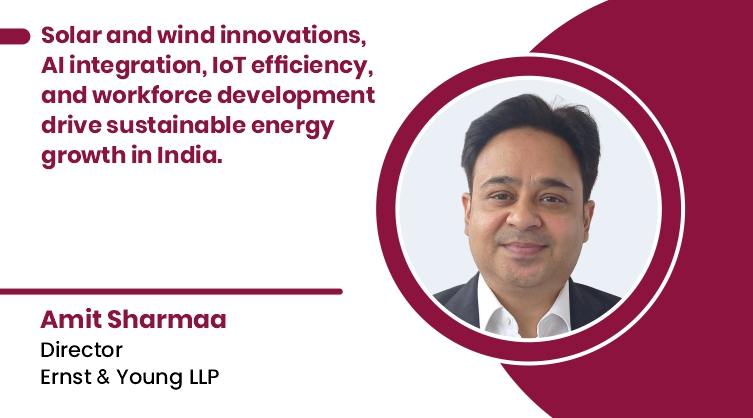Cutting-edge technologies transforming RE landscape
By EPR Magazine Editorial November 2, 2023 6:16 pm IST
By EPR Magazine Editorial November 2, 2023 6:16 pm IST

Solar and wind innovations, AI integration, IoT efficiency, and workforce development drive sustainable energy growth in India.
The importance of cutting-edge technologies in various domains cannot be overstated. In the context of renewable energy, specifically in solar and wind technologies, these advancements are vital. This article by Amit Sharma explores how cutting-edge technologies are revolutionising the renewable energy landscape in India, with a focus on solar and wind power. It also examines the impact of advanced technology on energy efficiency, integration, and the workforce.
Solar power advancements
In India, solar power has seen remarkable growth due to innovations in photovoltaic (PV) panels and concentrated solar power (CSP) systems. PV panels have become more efficient and cost-effective, leading to a significant reduction in solar panel costs. This has made solar power more affordable and accessible, resulting in a proliferation of solar installations nationwide. India is now one of the largest solar energy markets globally.
Concentrated solar power systems with energy storage capabilities provide uninterrupted power supply, especially in remote areas. This technology has enabled India to harness the sun’s energy effectively, contributing to its energy security and sustainability.
Wind power transformations
Wind power has been included in the pursuit of cutting-edge technologies. Advanced wind turbines with larger blades and smart control systems have improved energy capture, particularly in offshore wind farms. These advancements have harnessed stronger and more consistent winds, making wind power generation more efficient. India’s ambitious targets for offshore wind farms are driving technological advancements in this sector, ensuring a cleaner and more sustainable energy future.
Renewable energy integration
India has set ambitious targets for renewable energy integration, focusing on solar and wind power. Cutting-edge technologies such as advanced grid management systems, energy storage solutions, and smart grids have paved the way for seamlessly integrating renewables into the existing energy infrastructure. Predictive analytics and machine learning are crucial in managing the intermittency of renewable sources, ensuring a stable and efficient energy supply.
The role of artificial intelligenceArtificial intelligence (AI) and machine learning are becoming indispensable tools in the power and energy sector. They optimise energy generation, distribution, and consumption, improving reliability and cost-effectiveness. Demand forecasting, load optimisation, and predictive maintenance in power plants and grids are areas where AI is making a significant impact. AI-driven energy management systems help consumers optimise energy consumption and promote demand-side response, further enhancing efficiency and cost reduction.
Internet of Things (IoT) in energy efficiency
The Internet of Things (IoT) and data analytics enhance energy efficiency in various sectors, including industry, buildings, and transportation. Smart meters and sensors provide real-time energy consumption monitoring, allowing informed decision-making to reduce energy wastage. For instance, smart metering goes beyond mere data collection; it empowers users to make real-time decisions that benefit all stakeholders. IoT devices and sensors also enable real-time monitoring and control of energy assets, enhancing predictive maintenance and energy efficiency, a key aspect of sustainable energy practices.
While the influx of capital into India’s energy and power sector is promising, it comes with challenges. Regulatory uncertainty, frequent changes in energy policies, and land acquisition issues can create obstacles to long-term investments. Environmental and social concerns, especially in renewable energy projects, can lead to opposition from local communities and project delays. Bureaucratic red tape and infrastructure constraints also pose challenges.
Workforce development
In addition to technological advancements, nurturing a skilled workforce is essential for the growth and sustainability of India’s energy and power sector. A skilled workforce is crucial for innovation, technology adoption, energy security, energy efficiency, environmental sustainability, infrastructure development, and grid management. Investing in human capital is an investment in the future of the energy sector, which, in turn, is essential for economic growth, environmental sustainability, and the population’s well-being.
To conclude, integrating cutting-edge technologies in India’s renewable energy sector is driving significant advancements in solar and wind power. These innovations are vital for energy efficiency, integration of renewables, and the overall sustainability of the energy sector.
Spokesperson- Amit Sharma, Director- Ernst & Young LLP
We use cookies to personalize your experience. By continuing to visit this website you agree to our Terms & Conditions, Privacy Policy and Cookie Policy.